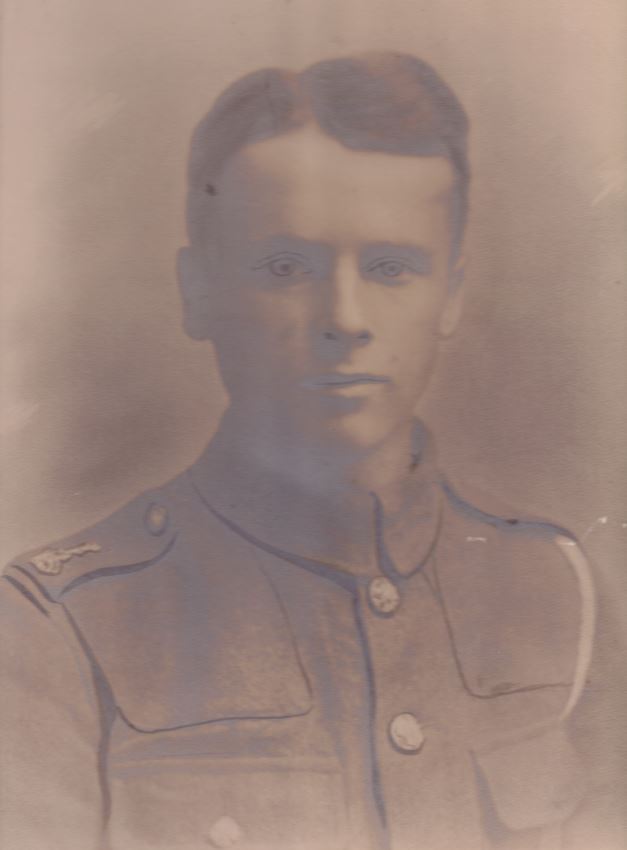Pte
Arthur Watson
Information about birth
|
Date of birth: 04/05/1894 |
|
Place of birth: Barking, Essex, England, United Kingdom |
General information
|
Profession: Labourer |
Army information
|
Country: England, United Kingdom |
|
Force: British Expeditionary Force |
|
Rank: Private |
|
Service number: 252384 |
|
Enlistment place: Barking, Essex, England, United Kingdom |
|
Units: — London Regiment, 2/3rd Bn. (Royal Fusiliers) (Last known unit) |
Information about death
|
Date of death: 26/10/1917 |
|
Place of death: Spider Cross Roads, Belgium |
|
Cause of death: Killed in action (K.I.A.) |
|
Age: 23 |
Memorial
|
Tyne Cot Memorial Panel: 149 |
Distinctions and medals 2
|
British War Medal Medal — 02/10/1920 |
|
Victory Medal Medal — 02/10/1920 |
Points of interest 2
| #1 | Place of birth | ||
| #2 | Enlistment place |
My story
Private Arthur Watson, a 23-year-old labourer from Barking, Essex, was killed on 26 October 1917 on the first day of the Second Battle of Passchendaele. Arthur served with the 2/3rd Battalion London Regiment (173rd Brigade, 58th Division).
At 5.40 a.m., zero hour, the 2/2nd and 2/3rd London Regiment advanced from their positions on the eastern outskirts of Poelkapelle. The 2/2nd set off to Cameron house, where it captured three German blockhouses. The 2/3rd Battalion, on the left, advanced towards Spider Cross Roads. Owing to the muddy ground the progress of the Battalion was very slow. Therefore the men were unable to keep up with the artillery barrage. On top of the condition of the terrain, the Battalion was held up at several points by German machine gun- and rifle fire. But despite these difficulties the 2/3rd kept on the attack, capturing several prisoners on the way.
Once the 2/3rd Battalion had reached positions near Spider Cross Roads, it was checked by heavy machine-gun fire. Between 7 and 10 a.m. the Battalion was forced to retreat. German counter-attacks on Cameron House had driven back the 2/2nd Battalion. With their right flank up in the air, the 2/3rd Battalion was in danger of being cut off, and had no choice but to fall back.
At the end of the day the whole 58th Division had almost been driven back to their original line. Casualties had been extremely high. Private Arthur Watson was one of the many who fell during the attack on the Spider Cross Roads. Arthur has no known resting place and he is remembered on the Tyne Cot Memorial to the missing.
At 5.40 a.m., zero hour, the 2/2nd and 2/3rd London Regiment advanced from their positions on the eastern outskirts of Poelkapelle. The 2/2nd set off to Cameron house, where it captured three German blockhouses. The 2/3rd Battalion, on the left, advanced towards Spider Cross Roads. Owing to the muddy ground the progress of the Battalion was very slow. Therefore the men were unable to keep up with the artillery barrage. On top of the condition of the terrain, the Battalion was held up at several points by German machine gun- and rifle fire. But despite these difficulties the 2/3rd kept on the attack, capturing several prisoners on the way.
Once the 2/3rd Battalion had reached positions near Spider Cross Roads, it was checked by heavy machine-gun fire. Between 7 and 10 a.m. the Battalion was forced to retreat. German counter-attacks on Cameron House had driven back the 2/2nd Battalion. With their right flank up in the air, the 2/3rd Battalion was in danger of being cut off, and had no choice but to fall back.
At the end of the day the whole 58th Division had almost been driven back to their original line. Casualties had been extremely high. Private Arthur Watson was one of the many who fell during the attack on the Spider Cross Roads. Arthur has no known resting place and he is remembered on the Tyne Cot Memorial to the missing.
Sources 6
|
"Passchendaele. The Day-by-Day Account", McCarthy C., London, Uniform, 2018, pg. 148. Sources used |
|
"The Royal Fusiliers in the Great War." O'Neill, H.C., London, William Heinemann, 1922, pg. 199-201. Sources used |
|
Ancestry https://www.ancestry.com/ Further reference |
|
CWGC https://www.cwgc.org/find-war-dead/casualty/826179/watson,-arthur/ Sources used |
|
The Long, Long Trail https://www.longlongtrail.co.uk/army/ Sources used |
|
War Diary London Regiment, 2/3rd Bn. (Royal Fusiliers) http://www.nmarchive.com/ Further reference |
